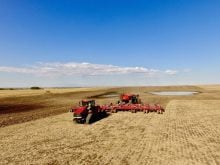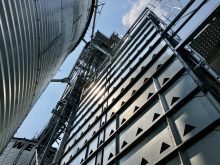Occasional plumes of smoke from distant wildfires may affect human comfort — but how does a smoke-obscured sun and poor air quality affect crops?
“This has been a big topic of conversation where I work in the state of Indiana,” says Dan Quinn, an assistant professor of agronomy and extension corn specialist at Purdue University. He spoke at the recent CropConnect conference in Winnipeg.
“I work primarily in corn, and Indiana is different in terms of climate and overall production than up here in Canada.”
Data from Canada’s National Forestry Database and the National Interagency Fire Center in the U.S. shows an uptick in forest fires over recent decades, Quinn notes. While a hotter, drier climate and more climate variability played a role in that increase, he said the most significant factor is forest management.
Read Also

Cancer agency reclassifies another herbicide ‘probably carcinogenic’
The WHO’s cancer research agency has now put atrazine, a herbicide well known to corn growers, in the same potential-hazard category where the agency put glyphosate.
“In the early 1900s, a lot of the forests were managed by prescribed burns, which helped mitigate some of the fuel load in these forests.”
But after a number of controlled burns got out of control, forest managers reduced the practice. Even where prescribed burns are done today, it’s getting more difficult. Specific weather conditions are needed for a prescribed burn, and a hotter, drier climate has reduced those windows.
Urbanization is another factor, with more populated centres near forests and uncomfortably close to potential wildfire sites.
A higher number of wildfires led to worry that the smoke would stunt crops, or at least not do them much good.
“My main answer to farmers when I get this question is ‘yes and no, and it’s complicated,’” Quinn says.
That’s probably not what farmers want to hear from their extension agronomist, he acknowledges, “but the way it breaks out is that wildfire smoke can negatively impact the crop, but it can actually positively affect the crop.”
The cons
Crops may be harmed for two reasons.
“The first one that everybody points to is the haze,” Quinn says. “If we have reductions in sunlight, that is going to impact the crop negatively. Wildfire smoke reflects sunlight. It can actually reduce that solar radiation and reduce photosynthesis in those crops.”
The other reason is higher levels of ground-level ozone, which can oxidize plant tissue.
“In really severe cases, when this happens, you can actually see tissue burned,” Quinn says.
It’s nearly impossible to study the direct effects of smoke on crops in a controlled environment. Researchers instead use analogues like cloud cover and other forms of shading to emulate the effects.
One Iowa study by Mark Jeschke from Pioneer Seeds, referenced by Quinn, looked at differences in photosynthetic active radiation, given different levels of cloud cover.
Under partly cloudy skies, there was a 23 per cent reduction in photosynthetic active radiation. Under full cloud cover without rain, there was a 52 per cent reduction, and under full cloud cover with rain, there was a 62 per cent reduction.
Another study in Ohio inadvertently looked at the impacts of wildfire smoke. It was tracking solar radiation across June and July for the years 2017 to 2021. During 2021, the study captured the impact of significant wildfire haze that blanketed the state.
“In 2021, you can see a seven per cent reduction in overall solar radiation in June and a six per cent reduction in overall solar radiation in July compared to the other four years,” Quinn says.
He was also able to extract information from weather sensors in northern Indiana, which track solar radiation.
“I pulled data from a stretch from June 24 through July 1 in 2023,” he says. “On June 25, 26 and 27, we were seeing a lot of that wildfire smoke.”
Solar radiation on those days was almost halved, he notes, “and the total solar radiation was reduced by about 32 per cent across that entire week.”
Whether a drop in radiation affects yield depends a lot on the timing of the smoke event.
Quinn pointed to a 2019 shading study from China, which showed a 50 per cent reduction in corn yield when solar radiation was reduced by 50 per cent between silking and maturity. Similarly, a 1992 University of Massachusetts study showed a 23–66 per cent reduction in corn yield when solar radiation was reduced by 50 per cent from 44 days after emergence to maturity.
In Ontario, a study in 2009 by the provincial ag ministry showed a three per cent yield reduction when radiation was halved prior to silking, a 12 per cent reduction when it was cut during silking, and a 21 per cent reduction when the cut came post-silking.
The pros
Those shading studies only tell part of the story. Wildfire smoke reflects sunlight, Quinn noted, but it also scatters it.
“If you scatter sunlight, it increases diffuse photosynthetic active radiation. That just means it can redistribute that sunlight; it means greater penetration of light into the canopy and actually can increase photosynthesis.”
This diffusion is most beneficial for taller crops that have multi-layered canopies, like corn.
Wildfire smoke may also reduce leaf surface temperature.
“When that wildfire smoke comes in, it may actually lower that leaf surface temperature and reduce plant transpiration, which gives that crop a little bit of a break,” Quinn says.
Again, timing is key.
“This is primarily beneficial during hot, dry conditions earlier in the season. It can also be negative if it’s later in the season and we’re trying to get that crop to mature.”
Last June, a plume hit Quinn’s area when corn was in its vegetative stage, so it may have been beneficial.
“We saw a 20 F (11 C) reduction in average air temperatures when the wildfire smoke came in late June, and we saw indications of lower transpiration rates and lower water loss for those crops,” he says.
Lower temperatures can also increase photosynthesis. A 2008 study out of Georgia showed a decline in one net photosynthetic unit for every 1 C increase in temperature.
While it’s difficult to quantify, Quinn said last year’s smoke in Indiana likely resulted in a net positive for corn grown in the state.
“Management practices may also play an important role,” he said. “There’s some indication that hybrids and plant densities can actually respond differently to changes in solar radiation. More research is just needed in this area.”
















